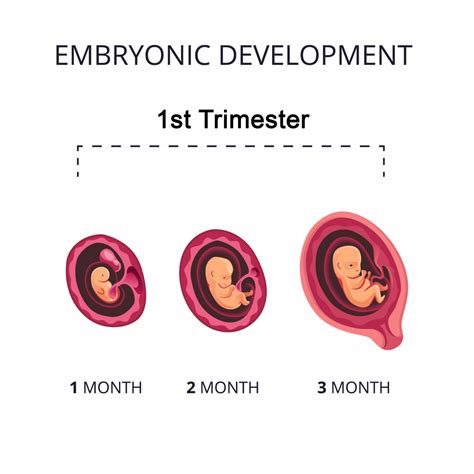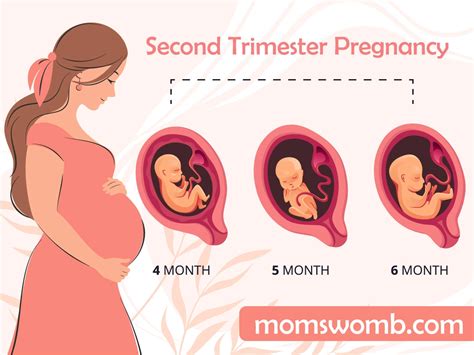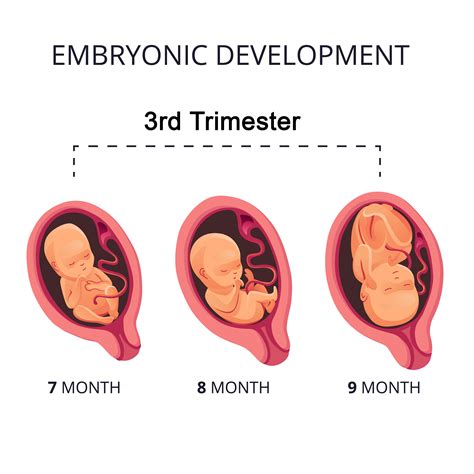Intro
Discover the 3 trimesters of pregnancy, from conception to birth, and learn about fetal development, prenatal care, and pregnancy stages, including symptoms and milestones, to ensure a healthy pregnancy journey.
Pregnancy is a remarkable journey that is typically divided into three distinct periods, known as trimesters. Each trimester brings its own set of physical, emotional, and developmental changes for both the mother and the growing fetus. Understanding these changes is essential for expectant mothers to navigate their pregnancy journey with confidence and preparedness. The three trimesters of pregnancy are crucial, and being aware of what to expect during each period can help alleviate anxiety and ensure a healthy pregnancy.
As the pregnancy progresses, the body undergoes significant transformations, and the fetus develops rapidly. The first trimester, which spans from week 1 to week 12, is a critical period of fetal development, during which the major organs and body systems begin to form. The second trimester, from week 13 to week 26, is often referred to as the "golden period" of pregnancy, as the initial symptoms of the first trimester start to subside, and the mother can feel the fetus moving. The third trimester, from week 27 to birth, is characterized by rapid fetal growth and preparation for labor.
The importance of understanding the three trimesters of pregnancy cannot be overstated. By being informed about the physical, emotional, and developmental changes that occur during each trimester, expectant mothers can better manage their health, make informed decisions, and ensure a smooth pregnancy journey. Moreover, knowing what to expect can help alleviate anxiety and fear, allowing mothers to focus on the joy and excitement of welcoming their new baby. In this article, we will delve into the details of each trimester, exploring the changes, developments, and essential tips for a healthy and happy pregnancy.
First Trimester: Weeks 1-12

Physical Changes During the First Trimester
Some notable physical changes that occur during the first trimester include: * Uterine expansion: The uterus expands to accommodate the growing fetus, which can lead to mild cramping and spotting. * Breast changes: Hormonal fluctuations cause breast tenderness, swelling, and darkening of the nipples. * Fatigue: Increased progesterone levels can cause drowsiness and fatigue. * Morning sickness: Hormonal changes can lead to nausea and vomiting, often triggered by certain smells or foods.Emotional Changes During the First Trimester
The first trimester can also be an emotionally challenging time for expectant mothers. Some common emotional changes include: * Mood swings: Hormonal fluctuations can cause irritability, anxiety, and mood swings. * Anxiety and fear: Concerns about the pregnancy, childbirth, and parenthood can lead to anxiety and fear. * Excitement and joy: The news of pregnancy can bring immense happiness and excitement.Second Trimester: Weeks 13-26

Fetal Development During the Second Trimester
The second trimester is a critical period of fetal development, during which the fetus: * Develops major organs and body systems * Grows hair, eyelashes, and eyebrows * Develops fat layers and gains weight * Practices breathing, swallowing, and suckingPhysical Changes During the Second Trimester
Some notable physical changes that occur during the second trimester include: * Uterine expansion: The uterus continues to expand, which can lead to mild cramping and discomfort. * Weight gain: The mother gains weight, primarily due to the growing fetus and increased blood volume. * Skin changes: Hormonal fluctuations can cause skin darkening, acne, and stretch marks.Third Trimester: Weeks 27-Birth

Physical Changes During the Third Trimester
Some notable physical changes that occur during the third trimester include: * Uterine expansion: The uterus reaches its maximum size, which can lead to mild cramping and discomfort. * Weight gain: The mother gains weight, primarily due to the growing fetus and increased blood volume. * Skin changes: Hormonal fluctuations can cause skin darkening, acne, and stretch marks.Preparing for Labor and Childbirth
The third trimester is a critical period for preparing for labor and childbirth. Expectant mothers should: * Attend prenatal classes: Learn about labor, childbirth, and parenting techniques. * Create a birth plan: Outline preferences for labor, delivery, and postpartum care. * Practice relaxation techniques: Learn breathing, meditation, and relaxation methods to manage labor pain.What are the most common symptoms of the first trimester?
+The most common symptoms of the first trimester include morning sickness, fatigue, breast tenderness, and mood swings.
How often should I attend prenatal appointments during the second trimester?
+Expectant mothers should attend prenatal appointments every 4-6 weeks during the second trimester.
What are the signs of labor during the third trimester?
+The signs of labor during the third trimester include frequent, intense contractions, back pain, and a bloody show.
In conclusion, the three trimesters of pregnancy are unique and critical periods of growth, development, and preparation for labor and childbirth. By understanding the physical, emotional, and developmental changes that occur during each trimester, expectant mothers can navigate their pregnancy journey with confidence and preparedness. We invite you to share your thoughts, experiences, and questions about the three trimesters of pregnancy in the comments section below. Additionally, feel free to share this article with expectant mothers or families who may benefit from this information. Together, we can support and empower women throughout their pregnancy journey.
